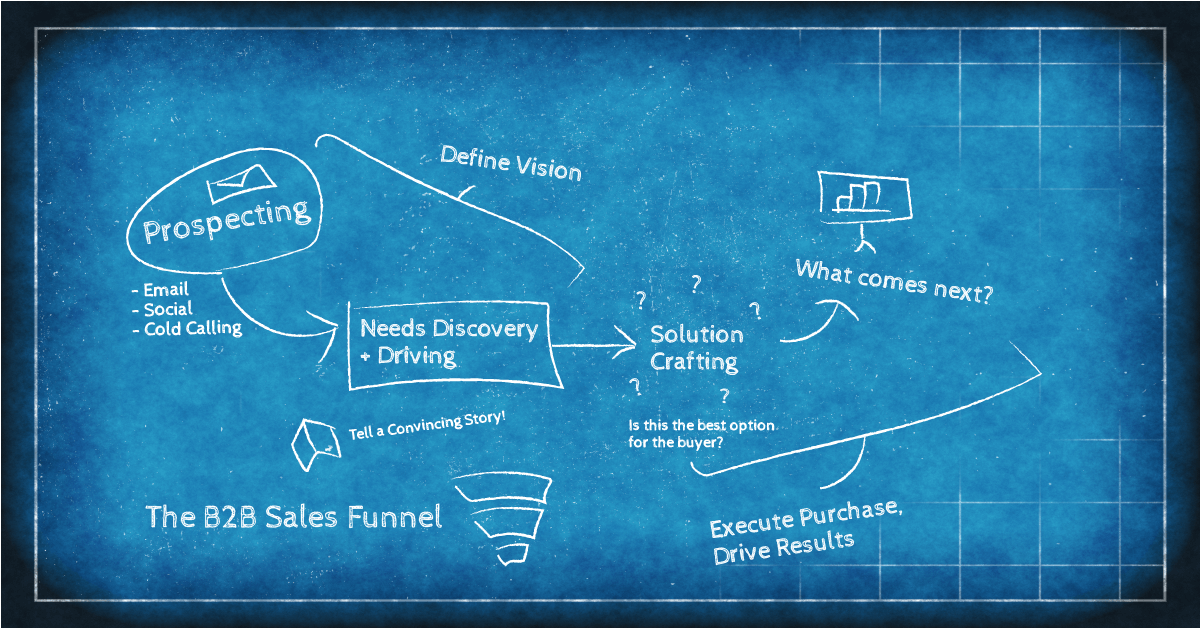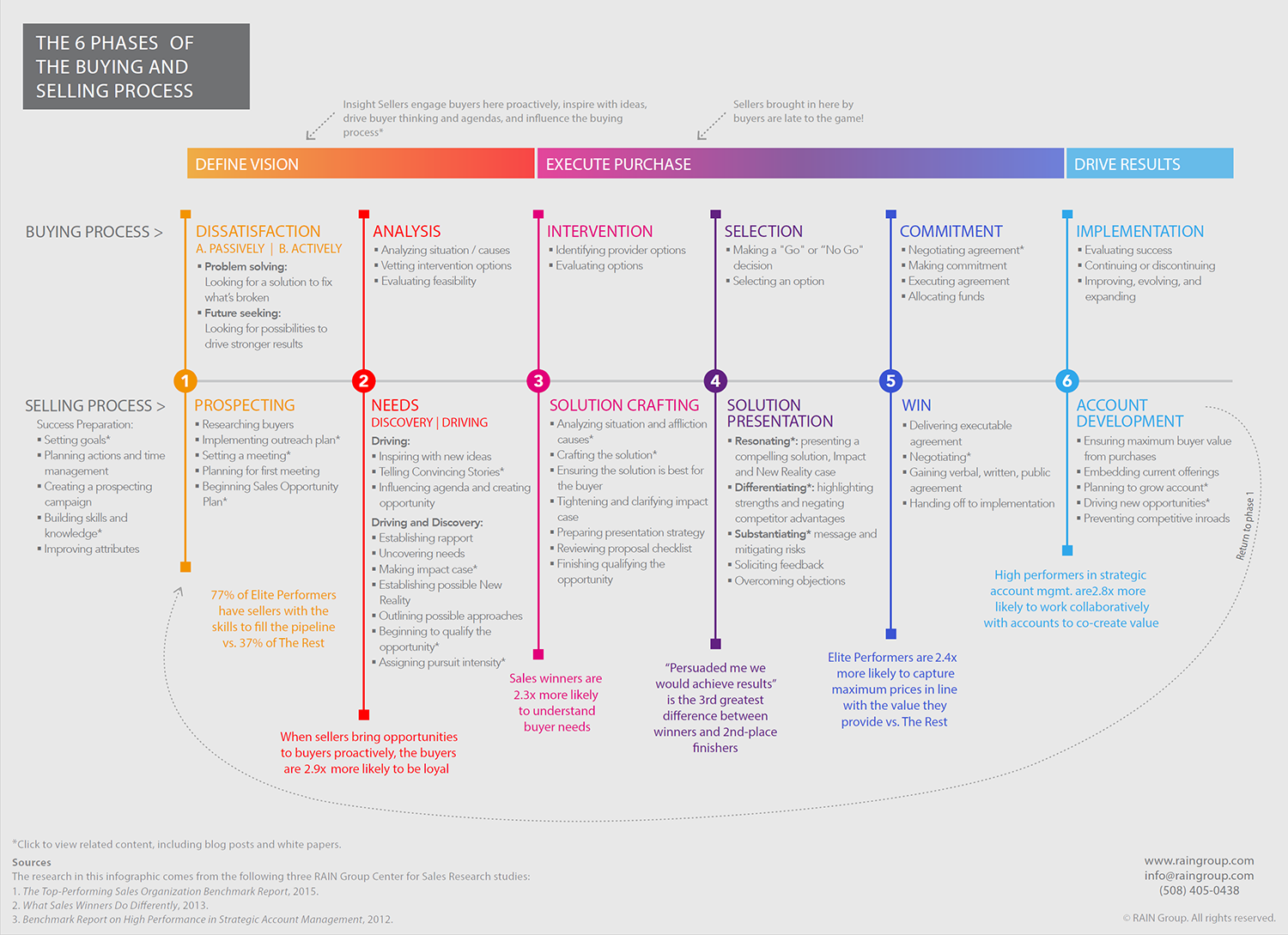Interesting tidbit: the concept of a sales funnel dates back to Chicago meatpackers in the late nineteenth century. Even then, the Armours, Swifts, and Morrises of the world were tinkering with the best strategies for selling their products to other businesses.
In many ways, the fundamental challenges of selling remain the same for the modern B2B sales funnel. That is, how to strike a chord with potential buyers—how to find alignment, create value, and deliver—instead of putting them through the same generic steps.
As you audit your existing sales funnel, or begin the hard work of constructing one, here’s an extensive look at each of the most critical B2B sales funnel stages, including core activities and tips for each phase.
What Is a B2B Sales Funnel?
A B2B sales funnel comprises each step that a potential buyer takes from the suspect/prospect stage to signing on as a new customer. Throughout all B2B sales funnel stages, buyers, sellers, and marketers will engage with each other in a variety of ways.
When we refer to a sales pipeline, we’re referring specifically to what the sales team does throughout this process. Generally, the sales pipeline involves a few key stages of its own, adjacent to but intertwined with the other moving parts in the funnel: prospecting, qualification of opportunities, initial meetings, defining need, proposals and negotiation, and closing. Finally, I must mention a critical metric in any discussion of a sales pipeline: conversion rate.
Why It’s So Important to Build a B2B Sales Funnel
First, the B2B sales funnel has to account for the evolving ways people buy. In the new B2B landscape, the buying process is far less sequential. Instead, buyers will explore, evaluate, engage, and experience at their convenience, moving through each stream in parallel (but not necessarily at the same time).
Recent research from McKinsey reveals compelling data in support of building a B2B sales funnel that can meet this demand for an omnichannel experience:
- Less than 50% of B2B companies grow market share selling through just one channel
- 72% of B2B companies that sell through seven or more channels (email, in-person, phone, website, etc.) grow their market share
- About 40% of organizations have added hybrid sellers in the past two years
Indeed, it’s about an approach to the funnel that accounts for context, while continuously building consensus and confidence. Not every buyer or stakeholder wants to see the same messaging or interact with sellers in the same ways.
For example, our research shows the different points at which buyers want to talk to sellers:
- When they're looking for new ideas and possibilities to drive stronger business results (71%)
- When they're actively looking for a solution to fix what's broken or to solve a problem (62%)
- When they’re analyzing a situation and its causes (49%)
- When they’re identifying and evaluating possible providers (54%)
- After a provider has responded to a request for proposal or quote (30%)
That’s not all. There are five important changes in B2B buying behavior that must be considered:
- The rise of procurement
- The quest for collaboration
- The evolution of the “act of selling”
- The role of risk
- The commoditization of most industries
Given this variety in buying behavior and diverse mix of decision makers for complex B2B deals, a thorough and resilient sales funnel is an absolute must.
What’s the Difference Between B2B and B2C Sales Funnels?
Up to this point, I’ve referred exclusively to the selling of products, services, and solutions to other businesses—also known as the B2B sales funnel. The B2B sales funnel differs from the business-to-consumer (B2C) sales funnel in a few notable ways:
- Entails more complicated dynamics, relationships, and business needs
- Involves more money, lengthy sales cycles, and numerous decision makers
- Requires different marketing content, such as case studies, white papers, and reports
Understanding the differences and inner workings of the different funnels is a precursor to B2B sales success.
The 6 Stages of a B2B Sales Funnel
At RAIN Group, we recognize six core stages of the B2B sales funnel:
- Prospecting
- Needs Discovery and Driving
- Solution Crafting
- Solution Presentation
- Win
- Account Development
What follows is an in-depth look at each stage, including information about their corresponding stage in the buying process and the skills necessary to excel in each.
Recently, developments in AI have provided sellers the tools to make managing your sales funnel more efficient. Perhaps you've already adopted AI tools to help you strategize, conduct research, or craft communications. Expect to see more sellers use it to refine their sales processes in the near future.
Click to enlarge and view the full PDF.
Stage 1: Prospecting
Buyers are out there looking for solutions to their problems or new ideas and possibilities to achieve stronger results. The challenge for sellers is to connect with those potential buyers in meaningful ways. This is where the prospecting stage begins—with sellers targeting the right buyers and generating demand.
Prospecting should by no means be a spray-and-pray activity. Instead, sellers should build and deploy a prospecting campaign—what we call an Attraction Campaign—to connect and set meetings with potential buyers. The Attraction Campaign should cover strategies for:
- Researching buyers
- Outreach
- Setting and planning for first meetings
- Opening new opportunities
Consistently filling the pipeline is the first step to becoming a top-performing seller.
In fact, our Top-Performing Seller research shows that Top-Performing Sellers are 50% more likely than other sellers to energetically prospect over the long term. Additionally, other research finds 77% of the best-performing organizations (what we call Elite Performers) have sellers with the skills to fill their pipeline, of which successful prospecting is an essential ingredient.
Stage 1 for Buyers: Dissatisfaction
All purchases begin with someone looking for a solution to a problem or seeking options to improve results. For example, a project coordinator at an interior design firm finds that spreadsheets are preventing the firm from scaling their client portfolio. They may search for a cloud-based solution to manage things like product selections, client communications, and approvals in one place.
A firm already using a cloud-based project management solution might want a more intelligence-driven solution, or one that can meet their particular business needs. There's always some next thing that buyers want—something that's appealing to them (a possibility) or nagging at them (a problem).
Stage 2: Needs Discovery and Driving
In this stage, sellers need to discover and drive the buyer’s needs by conducting a thorough needs discovery, asking insightful questions, and inspiring buyers with new ideas. In our research, we found that sales winners are 2.3x more likely to understand buyers’ needs compared to second-place finishers.
One important aspect of this stage is the ability to tell a convincing story. Sellers who do this stand to successfully drive and shape buyer needs while inspiring them to consider products or solutions they might be unfamiliar with. When sellers bring opportunities to buyers proactively, buyers are 2.9x more likely to be loyal.
Stage 2 for Buyers: Analysis
Here, buyers start analyzing their situation and pinpointing the sources of their dissatisfaction. They'll consider their options, begin vetting choices, and evaluate them for feasibility. In some cases, the buyers will go through their analysis with the seller themselves, as the result of a successful outreach campaign.
They might also conduct the analysis with business counterparts, at a trade show, or through their own research online. In any case, the seller is trying to sort out why they have issues and what their best, most realistic options are.
Stage 3: Solution Crafting
At this point, sellers should begin crafting a customized solution for their buyers. The solution crafting stage starts with a simple question:
Is this the best option for the buyer?
To answer this question, the seller analyzes the situation and causes of affliction before crafting a solution. They must tighten and clarify an impact case that demonstrates the buyer’s return on investment.
It’s at this stage the seller typically finishes qualifying the opportunity, prepares a presentation strategy, reviews their proposal checklist, and writes a proposal.
Research shows solution crafting is an area where Top-Performing Sellers are more likely to excel compared to other sellers, including:
- Collaborating with buyers deeply across the buying process (59%)
- Influencing buyer thinking about what to buy (57%)
- Crafting compelling solutions (45%)
Throughout this phase, it’s all about keeping the buyer’s needs first, not just selling a solution.
Stage 3 for Buyers: Intervention
When buyers reach this phase, they've determined they can't live without a solution. They begin identifying options from various providers and comparing the choices. Most likely, the seller isn’t the only one at the solution-crafting stage for a particular buyer.
Stage 4: Solution Presentation
It’s time for sellers to present their solution and show why the buyer should choose them. The solution presentation ought to accomplish three main objectives:
- Resonate: Present a compelling solution—including impact and new reality case—so buyers believe the seller "gets it" (Top-Performing Sellers are 51% more likely to present solutions compellingly).
- Differentiate: Highlight your strengths and negate any and all competitors’ advantages (Top-Performing Sellers are 55% more likely to make effective differentiation cases).
- Substantiate: Give substance to the message by providing proof that your solution can—and will—work, while mitigating any risks (Top-Performing Sellers are 51% more likely to inspire confidence buyers will achieve results).
Finally, don’t forget to solicit feedback and overcome objections from buyers, two additional steps that many sellers overlook.
Stage 4 for Buyers: Selection
In this phase, buyers decide if a solution is a go or no-go. It's time to select from the options available. A strong solution presentation can be the difference between success and failure. Our research shows that “persuaded me we would achieve results” is the third greatest difference between winners and second-place finishers.
Stage 5: Win
In all four previous stages, sellers must lay the foundation for value. The buyer needs to see and feel it. Yet, regardless of how strong the case is, sellers are still often pressed on price in the Win stage. But Elite-Performing Sales Organizations excel in this situation—they’re 2.4x more likely to capture maximum prices in line with the value they provide.
In addition to negotiating and delivering the price and terms of the agreement, sellers need to attain verbal, written, or public confirmation of the sale. It's also time to prepare to hand off the project to those in charge of implementation.
Stage 5 for Buyers: Commitment
In this phase, buyers negotiate the agreement, make a commitment, and execute. At that point, they’ll likely begin the allocation of funds, too.
Stage 6: Account Development
The sixth and final stage of the B2B sales funnel is where sellers ensure that their buyers achieve maximum value from their purchase. It’s where strategic account development can help drive new opportunities and grow the account while preventing any competitive inroads.
It's incumbent on sellers to embed their offerings and look for ways to continue to drive and deliver greater value. High performers in strategic account management are 2.8x more likely to work collaboratively with accounts to co-create value.
Stage 6 for Buyers: Implementation
With the solution in place, buyers evaluate the success of the purchase and determine whether to continue with the contract or seek another solution. Happy customers will likely continue to evolve and expand their use of the solution to become loyal, repeat customers.
As sellers create brand evangelists, they not only grow accounts, but also generate word-of-mouth referrals that might become the next sale. By working collaboratively with sellers, loyal customers can help improve solutions to deliver even greater value.
A Breakdown of B2B Sales Funnel Activities by Stage
1. Prospecting |
|
2. Needs Discovery and Driving |
Driving:
Driving and Discovery:
|
3. Solution Crafting |
|
4. Solution Presentation |
|
5. Win |
|
6. Account Development |
|
Expert Tips to Help You Best Approach the Stages of the B2B Sales Funnel
Once you understand these six stages from both the seller's and buyer's perspectives, you can create a truly world-class sales process. Sellers have a much better chance of winning when they know what they need to accomplish within each stage to build value for their prospects and leads.
The proof is in the win rate difference.
Here are five tips to help you stand out across the sales funnel:
1. Be the Beacon
Those we call Insight Sellers know how to engage buyers while defining the vision—they inspire with ideas, drive thinking and agendas, and influence the overall process. There’s a distinct pattern to how winners use insight to sell. They connect the dots and connect people. They position themselves as the best choice by helping their buyers make the best business decision. And they collaborate both on new ideas and the right path for realizing them.
2. Focus on Fit
To improve conversion rates and create more happy customers, sellers need to keep bad-fit prospects out of their pipelines. This starts with a specific prospecting plan and campaign.
You can also avoid pursuing the wrong prospects by being a lot more honest and transparent in how you answer the question, "Is this the best option for the buyer?" In addition, scrutinize where in the journey the buyer brought you in. We’ve found that sellers brought in by buyers at the execution phase are way behind the ball and won’t have much chance of closing.
3. Know Thy Competitors
Sales organizations that stay ahead of the competition don’t do so by accident. They run extensive, ongoing competitive analysis, from features/benefits breakdowns to product positioning and third-party industry analysis. One particularly useful strategy is to review lost deals to see what stakeholders talked about when they brought up the competition.
4. Automate Where Applicable
Across most B2B sales funnels, there’s ample opportunity for sensible automation. Think of the repeat tasks that sellers spend time on each day, like remembering to schedule meetings or CRM hygiene. Increasingly, sales organizations are turning to artificial intelligence (AI) to not only automate repetitive to-dos, but to uncover new insights and reporting about everything from pipeline health and forecasting to best practices and coaching.
5. Train for Success
Lastly, train sellers on your B2B sales funnel. Sellers should not only understand the fundamental stages as you’ve built them, but also develop an instinct for spotting winners and sensing when and how to handle certain scenarios. As part of this training program, look for ways to refresh sellers on an ongoing basis, tailor coaching programs, and provide the right tools and aides.
Final Thoughts: Work with a Sales Consultant to Optimize Your Funnel
We encounter many sales organizations that have diligently built out the six essential B2B sales funnel stages but still underperform. Maybe their funnel produces wins, but the same bottlenecks inexplicably tank big-ticket deals. Or maybe they’ve got the funnel but struggle to fill it with qualified leads.
This is where the honest assessment of a third-party consultant can be invaluable. For the same reason that all great novelists hire trusted editors, even the best of the best sales organizations come to RAIN Group to assess their B2B sales funnel.
You’ll find we match our trainers and consultants to clients based on similar industry focus and experience. Our programs are similarly tailored, as are our recommendations. More often than not, sales leaders are left with new insights into missing pieces that were in front of them all along.
They just needed a second set of trusted eyes.








